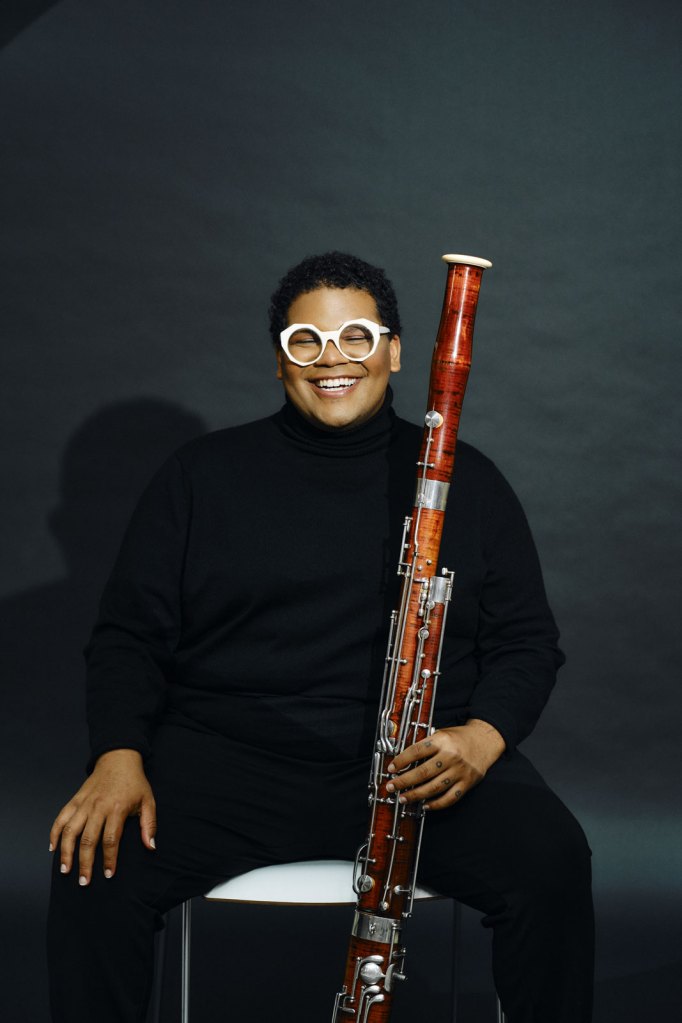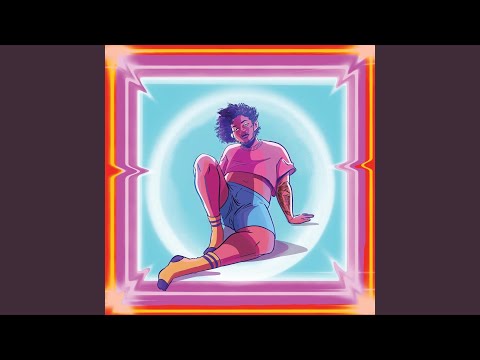Bassoonist-composer Joy Guidry is on a roll: In February they released their latest album, “Radical Acceptance”; they were the winner of the 2021 Berlin Prize for Young Artists; they will be starting a doctoral program in bassoon in the fall at the University of California San Diego. Guidry’s work extends beyond performing, composing, and improvising; they also founded Sounds of the African Diaspora, an initiative working to secure access to space and resources for composers from the African diaspora. Guidry’s own music is electroacoustic and ethereal, and frequently sonifies stigmatized topics such as mental illness and fatphobia. “Radical Acceptance” weaves together Black feminist thought, particularly the work of bell hooks, with a personal narrative encompassing experiences with psychiatric crisis, romantic turmoil, and family acceptance. Guidry and I met on Zoom to talk about the album and about Guidry’s perspective on tokenization, diversity, and glitch feminism.
VAN: Your music conveys such a strong sense not only of radical vulnerability but also of humor and warmth. I’m curious to hear about the evolution of your musical language over the past couple years—what have you found has changed, what has worked, what hasn’t worked?
Joy Guidry: What has worked is believing in my natural musical instincts, and remaining confident in that, while trying other types of music. It may not go so well in a reading or in a session, but I kinda take those experiences and say, “Why didn’t this go so well?” And then I see quickly that I was trying to be an artist that I’m not, and I’ll go back to the confidence that I have with my music and I’ll try to combine it with the new things instead of trying to reinvent a wheel.
My EP, “Darkness is a Myth,” has a lot of moments of maximalism and things like that. But making “Radical Acceptance,” it was like, we are in a completely different headspace now. Firstly, I’m medicated for my mental illness, and I can think very, very differently now. So I wanted to use different parts of my brain and do some ambient things, do some free jazz. I was really inspired by John Coltrane, Roscoe Mitchell, Jazmine Sullivan, Ari Lennox, you know, combining all these different forms of Black music… with the bassoon. The album was released in February but it’s been evolving as the band’s been performing it and I’ve been going on tour. And now I’m in a place with music where it’s going back to my roots of Houston, Louisiana, zydeco, gospel, Black folk. I’m starting the next project soon, and consciously scaling everything down, and giving some things the option to go towards maximalism. But not trying to force myself to keep adding—knowing when it’s OK to stop.
The latest from VAN, delivered straight to your inbox
You’ve been open in the past about the personal issues explored on “Radical Acceptance.” What was the process like, compositionally and emotionally, in sonifying issues of identity, particularly of gender?
The biggest thing about this album is that it’s all intersectional. My gender issues are race issues, my fatphobia issues are race issues, my queer issues are race issues. It never really broke apart, specifically in the first track [“Just Because I Have a Dick Doesn’t Mean I’m a Man”]. It covers all of what we’re going to get into. I wanted to have things that felt like I was lost, or searching—lost and searching—and that’s why track two is just an extension of track one. And there are so many Black artists that have what are being called projects now rather than albums: they are continuous. Take Beyoncé’s “Lemonade” or Janelle Monáe’s “Dirty Computer.” I wanted something that was continuous.
So I broke myself down and was able to go through each track and use music as therapy. And now I’ve learned that I don’t have to perform every track. I never perform the first track anymore. It’s too painful, especially if it’s in a room full of white people. Now I start the shows with improv bassoon and distorting and just go straight into a new, heavily electronic version of “Inner Child.” So I’ve taken it into a story of processing, showing love, showing fun in my life, and it’s really fun to perform now. I get nervous more with the tech than I do with the story and the pain.
The biggest thing I’ve learned from this album and self-exploration and processing is that people will take your identity and use it for marketing. If you do google me, most of the interviews keep saying “Joy, the fat Black queer…” and it’s like, “Stop using me as a punchline.” I’m being vulnerable with my story. You can just put “Joy, the bassoonist.” That’s been the thing with white publications and this album is that they want everything to be a minstrel show or something of that nature, and it’s so ironic because it’s like, “Did y’all actually listen to my album? I’m talking about you!” It’s shown me that I need to be more protective with my identity moving forward.
This album, all of my music and my work, is so deeply personal, and now I have the courage and the strength to correct people and not let them take my story and use it just for clickbait.

That was something I was wondering about: being labeled or pigeonholed as a “Black composer” or a “queer composer” rather than just as a composer. What are your thoughts on that problem of tokenization in the new music world?
That’s a difficult thing because I am a Black composer, a trans composer, all those different intersections. When I go around teaching diversity initiatives, I tell them, “If you’re going to do a concert in February for all-Black composers, but you’re never gonna program a Black person again that season, just don’t do the concert.”
I’m not pro getting rid of Brahms or Beethoven, that is great music. Then there’s also Florence Price, there’s George Lewis, Yvette Jackson, Cleo Reed, Lisa E. Harris, Matana Roberts, Margaret Bonds, Nina Simone. There are so many amazing artists out there. I think a perfect concert would be, like, Brahms’s “Tragic Overture”—fantastic piece. Have a piece by an indigenous person. Have a piece by a Black artist. Have a piece by someone from East Asia and someone from South Asia, because Asia is not a monolith; Africa is not a monolith. Have reality! Have what the world actually looks like.
I’m always curious to hear composers, particularly queer composers, talk about the relationship between the physical body and musical sound (which especially in classical music spaces is conceived of as “otherworldly”): in terms of performance, in terms of the relationship between the composer and performer, the composer and the instrument, the composer and the voice, how the listener might fit into all this. And I’m really eager to hear your thoughts especially in terms of your outspokenness about your own body.
To me that leads into the question of, Can you separate the art from the artist? To me it’s all connected. My music is me, everyone’s music is them, and it came from their own brain. I kinda stopped putting so much of my body into my music because I want to explore other things now, but when I was doing it, it was because this is the artist I am. People were trying to erase that part of me, and it’s like, “No, I’m also fat.” That’s the category we have to classify my body and I see nothing wrong with it, even if maybe other people see something wrong with it. I got so frustrated with it that me and my friend Olivia got together and wrote “She exists in several different time zones at once.” I wanted to show that this is who I am, this is the body behind this music.
With bodies and music and art, what helps me feel more comfortable with this kind of art-making, with contemporary art and free jazz and all these intersections, is remembering that the world was not made for someone like me. I read Legacy Russells’s “Glitch Feminism” this year and a lot of things clicked. We are in a system where a lot of things don’t go within the binary—I mean I’m literally non-binary. Same thing with Janelle Monáe’s “Dirty Computer,” it was so inspiring: to use your identity as your art. That has been a base of mine for a while and I’m excited to expand on that, and to leave my physical body and go a little more into my soul and my ancestry with this next album.
I really loved “Glitch Feminism” too, and your mention of it reminded me that you were working on “Radical Acceptance” during the early part of the pandemic. What was that process like? I feel like our “devices” were so critical for us during that time (even more than before) and I’m wondering if that shaped your compositional process.
I still feel very attached to my phone. The amount of time I spend on TikTok a day is a bit wild, but it makes me really happy. A lot of artists and academics try to judge others, like, “Oh, you shouldn’t spend so much time on your phone, you should go practice.” And it’s like, I’ve never spent so much time on my phone and I am so fucking successful. If you can’t spend hours on your phone a day and still get your work done, that’s on you! That’s very valid, but that’s not me.
I feel that devices are so demonized, and Legacy hit on this perfectly when they were talking about how white men will say, like, “I need to be off the grid,” but safe spaces for Black and brown queer and trans people are online spaces. White artists can just go out into the world and talk to who they want to talk to and be seen. This goes for white queer people and white trans people. Whiteness is whiteness. Whiteness across the entire gender spectrum is represented. Of course I say this with care and love, that white trans people do not get as much representation as white cis gay men or white cis lesbians. But white trans people still get a hell of a lot more representation than Black, brown, indigenous trans, two-spirit, and non-binary people do, and kind of always will. Devices have helped me find other people that look like me, helped me see people that look like me be raised up, help me be raised up, teach me about accountability, teach me about restorative justice.
I know I didn’t really get into the composition part, but I put my life into my music, and all of the last two years has formed who I am [and] the sonic part of my music. I have been struggling a lot with how I identify as an artist lately. But even though I’m confused on where to put my music, I know that my music is very valid, and I know that I will always have a place in this world, a place in the music industry, a place within my family and friends, and some of these places I’m going to make my own space, but when it comes to my family and friends and community, I’ve learned through radical acceptance that I should never have to fight to be seen, to be loved, to be heard, to be cared for. Those things should happen naturally. ¶
Subscribers keep VAN running!
VAN is proud to be an independent classical music magazine thanks to our subscribers. For just over 10 cents a day, you can enjoy unlimited access to over 875 articles in our archives—and get new ones delivered straight to your inbox each week.
Not ready to commit to a full year?
You can test-drive VAN for one month for the price of a coffee.




